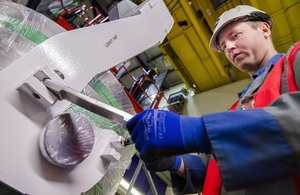Sellafield clean-up reaches crucial milestone
One of the biggest tasks in the clean-up of Sellafield is half way to completion.

Workers at Sellafield site
Workers have now removed 50 per cent of the radioactivity from the site’s oldest nuclear fuel pond.
The milestone was achieved this month (October) when the final ‘canned fuel’ was transferred from the facility to a modern handling plant, operated by the National Nuclear Laboratory (NNL).
The Pile Fuel Storage Pond is a relic from the Cold War when Sellafield produced material for the UK’s nuclear deterrent. It is one of four high hazard facilities on the site prioritised for clean-up by the Nuclear Decommissioning Authority (NDA).
It needs to have its contents removed so it can be drained and demolished.
This is hugely challenging because the facility was not built with decommissioning in mind.
The fuel stored there is several decades old, some of it is in a fragile state, and the pond building itself had to undergo many years of improvements to be able to withstand retrieval operations.
Despite these challenges, huge progress is being made.
Paul Foster, Managing Director of Sellafield Ltd, said:
I’m immensely proud of the progress we’re making in the Pile Fuel Storage Pond.
Removal of the entire canned fuel inventory is a major step towards decommissioning this facility and reducing the risk posed by Sellafield’s legacy facilities.
This is a fantastic example of how closer collaboration with our colleagues in Government, the NDA, our regulators and NNL is delivering fit-for-purpose solutions to the accelerated clean-up of the site.
Pete Lutwyche, the NDA’s Sellafield Programme Director, said:
The four key legacy facilities are not just ours but the Government’s and our regulator’s key priorities at Sellafield.
This is another significant step forward in hazard reduction on the site.
I feel fortunate to be able to see first-hand the excellent progress being made and the tremendous teamwork and expertise required to deliver it.
Andy Lindley, Director of ONR’s Sellafield Programme, said:
We are encouraged by the progress made by Sellafield Ltd to remove and process canned fuel from PFSP.
The remediation of fuel and sludges from the legacy ponds has been gathering pace during 2015 and the success in removing canned fuel is a key milestone in the long term goal of achieving risk and hazard reduction at the site.
Work is ongoing around-the-clock to remove the remaining contents of the pond, including ‘metal fuel’, which is expected to be cleared by April next year.
Once achieved, more than 70 per cent of the pond’s radioactivity will have been removed.
Attention will then switch to clearing other wastes, including sludge.
The date at which the pond will be ready for draining has been brought forward 21 years since the 2011 estimate and is on track to shave £700m from the original estimated cost.
Sellafield
- Europe’s most complex nuclear site
- Employs more than 10,000 people
- Driver of local economic growth
- Focused on accelerated risk and hazard reduction
Pile Fuel Storage Pond
- Built in the 1940s
- Supported plutonium production at Windscale
- Prioritised for clean-up by the Nuclear Decommissioning Authority (NDA)
- Contains 1,000 different waste, including fuel, equipment and radioactive sludge
Canned fuel
- Stainless steel cans containing fuel pins, pellets and cladding waste
- Used in the Windscale Advanced Gas-cooler Reactor
- Reactor was the prototype for AGR stations now operating across the UK
- 191 cans (2.5tn) of fuel removed and transferred to modern handling plant